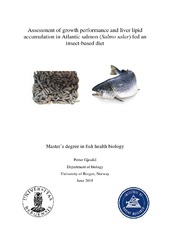Assessment of growth performance and liver lipid accumulation in Atlantic salmon (Salmo salar) fed an insect-based diet
Master thesis
Permanent lenke
https://hdl.handle.net/1956/18090Utgivelsesdato
2018-06-26Metadata
Vis full innførselSamlinger
Sammendrag
Increase in price and reduced availability of fish meal (FM) has caused the aquaculture industry to look at alternative sources for nutrients for feed production. Vegetable protein sources can replace a substantial part of FM and has been doing so in recent years. Vegetable sources do, however, have limitations due to an unbalanced amino acid (AA) profile, being high in fibre, antinutritional factors and competition with human consumption. Alternative sources for protein must be considered for increased flexibilities in future fish feed production. In this study, insect meal (IM) made from Black soldier fly (Hermetia illucens) pre pupae fed on brown algae (Ascophyllum nodosum) enriched medium was used to substitute 100% of the fishmeal in a diet for Atlantic salmon (Salmo salar) in seawater. Commercially available feed was used as control. The diets were balanced so no nutrient deficiencies were expected to have an impact on growth and other health parameters. After 16 weeks, fish length and weight were recorded and hepatic- and visceral somatic indices measured. No differences in growth and survival were discovered. The liver lipid accumulation was evaluated through histology to assess the size of hepatic lipid droplets and by lipid class analysis. Histology did not reveal any difference between the dietary groups in the size distribution of lipid droplets, and lipid class analysis did not show any significant differences in lipid class composition. In all, the IM based diet used in this trial showed great potential as feed in future Atlantic salmon farming.
